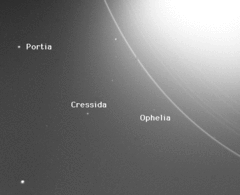Cressida (moon)
Cressida is a closer moon to Uranus. It was found from the images taken by Voyager 2 on 1986-01-09, and was given the designation S/1986 U 3.[5] It was named after the Trojan daughter of Calchas, a tragic heroine who appears in William Shakespeare's play Troilus and Cressida (as well as in tales by Geoffrey Chaucer and others). It is also designated Uranus IX.[6]
| Discovery | |
|---|---|
| Discovered by | Stephen P. Synnott / Voyager 2 |
| Discovery date | January 9, 1986 |
| Orbital characteristics | |
Mean orbit radius | 61,766.730 ± 0.046 km[1] |
| Eccentricity | 0.00036 ± 0.00011[1] |
| 0.463569601 ± 0.000000013 d[1] | |
| Inclination | 0.006 ± 0.040° (to Uranus' equator)[1] |
| Satellite of | Uranus |
| Physical characteristics | |
| Dimensions | 92 × 74 × 74 km[2] |
Mean radius | 41 ± 2 km[2] |
| ~20,000 km²[3] | |
| Volume | ~260,000 km³[3] |
| Mass | ~3.4×1017 kg[3] |
Mean density | ~1.3 g/cm³ (assumed) |
| ~0.013 m/s2[3] | |
| ~0.034 km/s[3] | |
| synchronous[2] | |
| zero[2] | |
| Albedo | 0.08 ± 0.01[4] |
| Temperature | ~64 K[3] |

Cressida belongs to Portia Group of moons, which also includes Bianca, Desdemona, Juliet, Portia, Rosalind, Cupid, Belinda and Perdita.[4] These moons have similar orbits and photometric properties.[4] Other than its orbit,[1] radius of 41 km[2] and geometric albedo of 0.08[4] almost nothing is known about it.
At the Voyager 2 images Cressida appears as a stretched object, the major axis pointing towards Uranus. The ratio of axes of Cressida's prolate spheroid is 0.8 ± 0.3.[2] Its surface is grey in color.[2]
References
Other websites
- Cressida Profile Archived 2007-06-08 at the Wayback Machine by NASA's Solar System Exploration